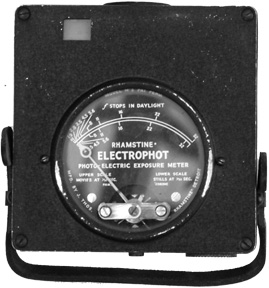
|
  Maker: Rhamstine Model: Electrophot M-S Circa: 1932 Designer: J Thos Rhamstine Cell type: Selenium Measure type: Reflecting/averaging |
|
John Thomas Rhamstine, from what little I've been able to ferret out, appears to have been a relatively small manufacturer based in Detroit, Michigan. I believe his bread-and-butter was electrical piece-parts for radio, but I'm not sure. Regardless, from the early 1930s to the early 50s, Rhamstine sold photoelectric light meters under the name Electrophot. You know how everything is listed as being "rare" on eBay? These actually are. They are around but you simply don't see them for sale very much. They weren't big sellers—not in the Weston, General Electric, DuJur league from that era—and they didn't buy big national advertisements, and they didn't get much ink in the photo magazines. So unfortunately, it's very difficult for me to piece together what's what, other than what I've been able to find here and there. Forgive me if this is particuarly vague and filled with qualifiers, but I'd rather be honest and accurate than authoritative and wrong. Rhamstine is often credited with inventing the first photo-electric meter; the earliest mention I've found is from a magazine called Movie Makers, October 1931, pp. 544 and 548. It was round with a cylinder on the top. It was the first to use a selenium cell but it also required a battery (this was a Grippenburg cell). $35 in depression-era money; that's not cheap. See the advertisement below, far left. In April of 1932, they redesigned it as a square box. This was the DHA model. Still took batteries. The face is black printing on a white background. The price was reduced to $35. See the advertisement below, center. By December of 1932, they redesigned it to eliminate the batteries but kept the case (this used a Fritts cell). It still has the battery cover and the hardware inside to hold the battery, but it isn't actually used.. The face was inverted to white-letters on a black background, and called it the Model M-S. Price was now reduced to $28.50. See the advertisement below, far right. This is the version that I have. It is big and heavy (more than you'd want hanging around your neck or weighing down a coat pocket). It could be used in the field, but I think it was meant for studio use where it would spend most of its time on a tabletop and wouldn't have to be lugged around. Actually, it's a direct-reading reader meant for movie work. If you're using a popular film stock with a standard shutter speed, the face reads out in ƒ/stops. You need to consult the table on the back (or in a booklet) to convert it for other uses. One of the great ironies of history is that this meter was about 30 years before its time. All these meters used selenium cells to measure the amount of light striking them. But whereas Weston, Gossen, General Electric, DeJur and the others used photovoltaic cells which generated current that could be measured with a milliammeter, Rhamstine used the cell as a photoresistor: he applied electrical current across it and measured the amount of resistance across the cell using an ohmmeter. This solution required a battery, which were kind of like automobile batteries are today: big and inefficient. So while Rhamstine had all this extra size and weight, his competitors made much smaller units which were more attractive to photographers in the field; and they ate his lunch. Subsequent Electrophots (like my model 14-A) were photovoltaics. In the early 1960s the cadmium sulfide (CdS) cell came out and it was a photoresistor. They used little button batteries so the meters were as small and light as the contemporary selenium models, and they blew the selenium cell meters out of the water almost overnight. If Rhamstine had been able to downsize his meter and run it off a button-battery, things might have turned out very differently. Rhamstine then redesigned it again, this time with a much smaller, lighter case, and called it the M-S-A and M-S-B. |
|
.jpg)
.jpg)
.jpg)
|
|
©opyright by James Ollinger. All Rights Reserved.
Company names and models are registered trademarks of their respective owners
and are not affiliated with this website in any way.
